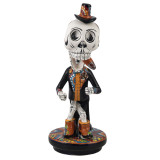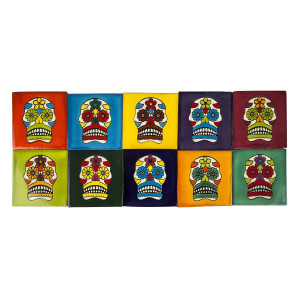Catrin Posadas - traditional Talavera statue from Mexico
- Original figurine representing a man.
- Based on the traditional motif of La Catrina - the skeleton figure
- Hand made and hand painted by Mexican artists.
- Dimensions H 58, W 20 cm
- Securely packaged.
- Delivered from warehouse in Poland
Figures of men in La Catrina style
La Catrina referred in a mocking way to the "wives of fashion," ladies who wanted to resemble their European counterparts. The garbancera was the female equivalent of the dandy, the buffoon, the dandy, whom Diego Rivera (Frida Kalho's husband) called Catrina. Therefore, it is not surprising that figurines of male counterparts of La Catrina, referring to the original, are becoming more and more popular. The figurines depict a man without a corporeal shell, a skeleton in a Mexican hat or sombrero, often in various everyday situations, on a horse or a bicycle. La Catrin men are often dressed in traditional Mexican costumes, these may be clothes such as Mariachi or elegant tailcoats and cylinders.
The Mexican La Catrina
La Catrina is a figure that was invented by José Guadalupe Posada, referring in its design to the Mexican festival of the dead. The figures do not have any religious significance, instead they mark the presence of the spirits of people who have ended their earthly lives. Catrines symbolize transience, inevitability of death, regardless of wealth or social status. Mexicans believe that death is just a part of life and it is not worth to be afraid of something inevitable. Perhaps death is a ticket to a better, more joyful life. During the Mexican holiday of the dead it is very popular for women to dress up as Catrina and men as Catrinas. Dead body makeup is ubiquitous, with the emphasis on blue eye sockets and bared teeth. Faces are usually further decorated with colorful flowers.
La Catrina referred in a mocking way to the "wives of fashion," ladies who wanted to resemble their European counterparts. The garbancera was the female equivalent of the dandy, the buffoon, the dandy, whom Diego Rivera (Frida Kalho's husband) called Catrina. Therefore, it is not surprising that figurines of male counterparts of La Catrina, referring to the original, are becoming more and more popular. The figurines depict a man without a corporeal shell, a skeleton in a Mexican hat or sombrero, often in various everyday situations, on a horse or a bicycle. La Catrin men are often dressed in traditional Mexican costumes, these may be clothes such as Mariachi or elegant tailcoats and cylinders.
The Mexican La Catrina
La Catrina is a figure that was invented by José Guadalupe Posada, referring in its design to the Mexican festival of the dead. The figures do not have any religious significance, instead they mark the presence of the spirits of people who have ended their earthly lives. Catrines symbolize transience, inevitability of death, regardless of wealth or social status. Mexicans believe that death is just a part of life and it is not worth to be afraid of something inevitable. Perhaps death is a ticket to a better, more joyful life. During the Mexican holiday of the dead it is very popular for women to dress up as Catrina and men as Catrinas. Dead body makeup is ubiquitous, with the emphasis on blue eye sockets and bared teeth. Faces are usually further decorated with colorful flowers.
Product Details
- Product code: AVE-FG-9
- Manufacturer: Cerames
- Colour Multicolor
- Material Ceramic
- Application Inside
- Country of origin Mexico
You might also like



















